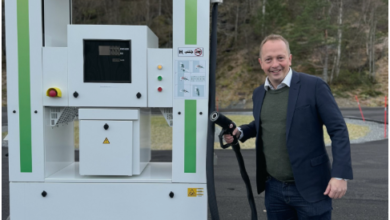Norwegian Hydrogen receives grant to build hydrogen fueling stations in Sweden

Norwegian Hydrogen has received NOK 20 million in grants from the Swedish Energy Agency for the construction of a hydrogen filling station in Visby on Gotland. “Another important milestone for us,” says Per Øyvind Voie, Managing Director for refueling in Norwegian Hydrogen.
“This marks the start of building a new network of hydrogen filling stations aimed directly at heavy transport and is thus a major and important milestone for us. When the station opens, it will have a capacity of at least 1500kg of hydrogen per day, which is enough to fill 30-40 heavy-duty trucks.”
The support Norwegian Hydrogen has received comes from a support program called Regional Electrification Pilots. Through the program, the Swedish Energy Agency has provided support for a total of 13 new hydrogen fueling stations. The grant is intended to cover 100% of the costs, but Voie assumes that the total cost will be somewhat higher than SEK 20 million. “We see that the prices of equipment have increased significantly lately, and the grant will therefore not cover the entire investment. The overall support rate will nevertheless be very good compared to for instance in Norway.”
In Norway, the maximum support rate for filling stations is 40%. But first, an end customer must have invested in heavy trucks. “I would encourage Norwegian politicians to learn from Sweden. The infrastructure must be in place first if we are to succeed in cutting emissions from heavy transport, and then the level of support must be increased. In Sweden, they launch competitions to decide who should receive grants to build their infrastructure.
Norwegian Hydrogen has great ambitions and is in the process of building a network of hydrogen fueling stations aimed at heavy transport throughout the entire Nordic region. Last week, it was announced that the company acquired HydRe Oy, a Helsinki-based company hydrogen fueling company, focusing on Finland and the Baltics.
“We are actively working to find relevant locations, develop them, get in touch with potential customers, and trigger public support in order to expand the network as quickly as possible. Our goal is for trucks and other heavy vehicles to be able to drive emission-free. Then the infrastructure must be in place – and we will take a lead I this process,” concludes Per Øyvind Voie.
